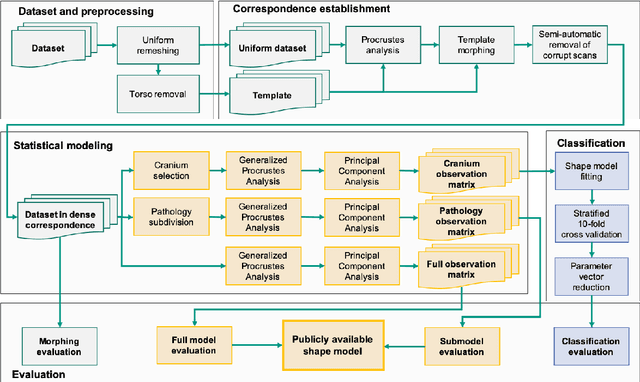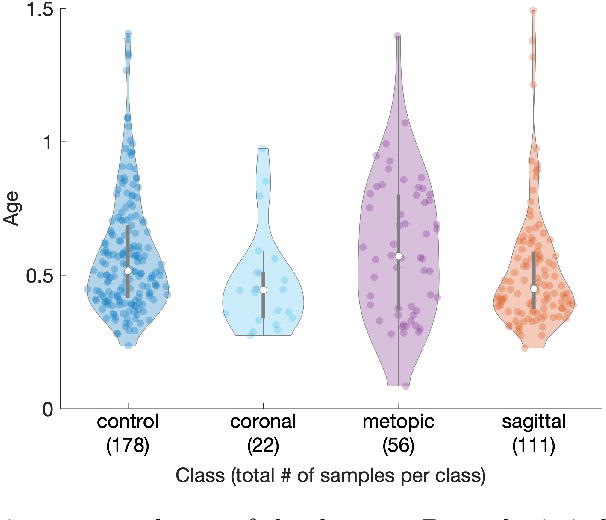Andreas Wachter
Impact of Data Synthesis Strategies for the Classification of Craniosynostosis
Oct 16, 2023



Abstract:Introduction: Photogrammetric surface scans provide a radiation-free option to assess and classify craniosynostosis. Due to the low prevalence of craniosynostosis and high patient restrictions, clinical data is rare. Synthetic data could support or even replace clinical data for the classification of craniosynostosis, but this has never been studied systematically. Methods: We test the combinations of three different synthetic data sources: a statistical shape model (SSM), a generative adversarial network (GAN), and image-based principal component analysis for a convolutional neural network (CNN)-based classification of craniosynostosis. The CNN is trained only on synthetic data, but validated and tested on clinical data. Results: The combination of a SSM and a GAN achieved an accuracy of more than 0.96 and a F1-score of more than 0.95 on the unseen test set. The difference to training on clinical data was smaller than 0.01. Including a second image modality improved classification performance for all data sources. Conclusion: Without a single clinical training sample, a CNN was able to classify head deformities as accurate as if it was trained on clinical data. Using multiple data sources was key for a good classification based on synthetic data alone. Synthetic data might play an important future role in the assessment of craniosynostosis.
A statistical shape model for radiation-free assessment and classification of craniosynostosis
Jan 10, 2022



Abstract:The assessment of craniofacial deformities requires patient data which is sparsely available. Statistical shape models provide realistic and synthetic data enabling comparisons of existing methods on a common dataset. We build the first publicly available statistical 3D head model of craniosynostosis patients and the first model focusing on infants younger than 1.5 years. For correspondence establishment, we test and evaluate four template morphing approaches. We further present an original, shape-model-based classification approach for craniosynostosis on photogrammetric surface scans. To the best of our knowledge, our study uses the largest dataset of craniosynostosis patients in a classification study for craniosynostosis and statistical shape modeling to date. We demonstrate that our shape model performs similar to other statistical shape models of the human head. Craniosynostosis-specific pathologies are represented in the first eigenmodes of the model. Regarding the automatic classification of craniosynostis, our classification approach yields an accuracy of 97.3%, comparable to other state-of-the-art methods using both computed tomography scans and stereophotogrammetry. Our publicly available, craniosynostosis-specific statistical shape model enables the assessment of craniosynostosis on realistic and synthetic data. We further present a state-of-the-art shape-model-based classification approach for a radiation-free diagnosis of craniosynostosis.
Workflow Augmentation of Video Data for Event Recognition with Time-Sensitive Neural Networks
Sep 30, 2021



Abstract:Supervised training of neural networks requires large, diverse and well annotated data sets. In the medical field, this is often difficult to achieve due to constraints in time, expert knowledge and prevalence of an event. Artificial data augmentation can help to prevent overfitting and improve the detection of rare events as well as overall performance. However, most augmentation techniques use purely spatial transformations, which are not sufficient for video data with temporal correlations. In this paper, we present a novel methodology for workflow augmentation and demonstrate its benefit for event recognition in cataract surgery. The proposed approach increases the frequency of event alternation by creating artificial videos. The original video is split into event segments and a workflow graph is extracted from the original annotations. Finally, the segments are assembled into new videos based on the workflow graph. Compared to the original videos, the frequency of event alternation in the augmented cataract surgery videos increased by 26%. Further, a 3% higher classification accuracy and a 7.8% higher precision was achieved compared to a state-of-the-art approach. Our approach is particularly helpful to increase the occurrence of rare but important events and can be applied to a large variety of use cases.
 Add to Chrome
Add to Chrome Add to Firefox
Add to Firefox Add to Edge
Add to Edge